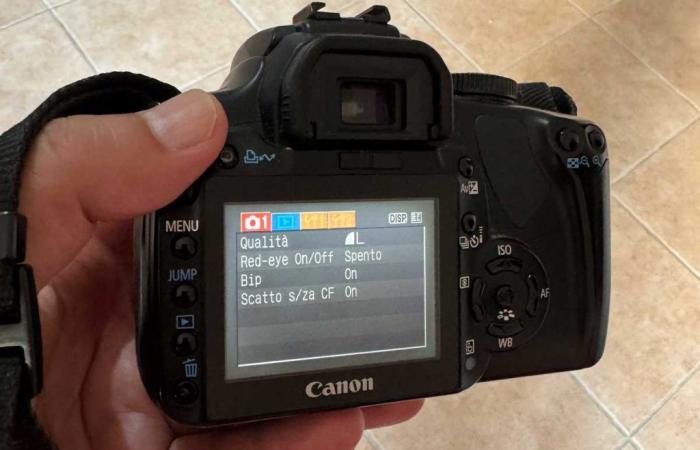There is one of those deep mysteries that users cannot explain but which evidently companies have (secret) reasons not to reveal and pursue. And that mystery impacts the camera market. All or almost all of the big manufacturers (we’ll see this in a moment) continue to produce cameras with ridiculous menus, complex beyond good and evil, and which are an obstacle that causes friction to the activities of photographers, not a tool for improvement. Even for professionals.
Now let’s explain better.
L’asteroide iPhone
Sometime in 2007, an asteroid hit the planet of cameras. That asteroid is the iPhone. An asteroid that caused some sort of nuclear reaction that hasn’t finished yet, with debris and lapilli and everything else falling everywhere. What happened?
Apple has laid the groundwork to bring an even more radical approach than that of the age-old point-and-click cameras to the world of photography, starting with smartphones. Not only did she do it, because then Android and then others also got involvedwe’ll get to it straight away, but the starting point is this: the smartphone camera (including the iPhone) was ridiculous from a quality point of view, but he had very clear ideas about how to take photosThe person points and shoots, the processor takes care of everything else.
The birth of a new species
This philosophy has remained consistent, everything else around has changed: the sensor has become very powerful, the optics have improved a lot, the processor is a rocket, there are algorithms that we could not even imagine. The result? With the iPhone today you can take spectacular photos without needing an extremely complex interface. And even the pro apps actually free up 2-3 variables and are very uncomplicated.
This revolution on the smartphone side it has been seen as an evolution of the logic of point-and-click cameras, those that have always existed, used to take photos on film and then also digitally with ultra-compact cameras with microsensors, but in reality the story is different.
Yes, because the ultra-compact and point-and-click ones, analogue or digital, are extremely limited machines, which leave zero or very few automatisms (an exposure meter that often misfires, two or three times, two or three apertures and little else) and they can’t take quality photos even if they wanted to. Instead, the iPhone wanted a minimalist interface that hid all the complexity of the world, with the ambition of eliminating as many cameras and video cameras as possible.
The arrogance of the big names
What happened in the other world instead? Nikon, Canon, Sony, Pentax, Fuji, Ricoh and all the others who have landed in the digital world, all of them Japanese (but there was also the Korean Samsung for a period with beautiful APS-C digital SLRs) have discovered the joy of finesse configuration. And they created dozens and dozens of nested menus, with problematic navigation, enigmatic labels, completely broken logic and a surreal approach to managing the photographic act.
If the purpose of the camera is “get” the image the author wants and how the author wants while minimizing friction, it can be said that they have completely failed in their objective. And I’m not talking about optics, sensors or CPUs: I’m really talking about software interfaces.
The photo we would like and could take (but can’t)
Because you see, if you think about it for a moment it is almost obvious. Let’s get out for a moment from the distinction between professional photographer, amateur, lover, artist and all the rest. Let’s simply think about digital photography. There are two ways of shooting: Raw e Jpeg. These two photos have two completely different purposes: one retains a lot of potential that must be processed later, during the digital development phase. The purpose of Raw today, however, is no longer to have an “artistic” or “expressive” developmentthat is, that allows the author to do something else. Instead, digital development has become something else: a correction: it comes from the fact that the author of the photo he can no longer take the photo he could and wants to take and therefore he has to correct it heavily in post.
Let’s see the JPEG: after being born to give space to more images on cameras with little memory, it has become a tool for immediate sharing and also a “snapshot” approach. You can also retouch with the same tools used for Raw, but it already makes less sense because the corrections that can be made are fewer. So, to solve this problem, what have camera manufacturers done? “Filters” have been invented with names that recall old films or that express ideas. They are evolutions (less sophisticated but conceptually similar) to the “scenes” in which the camera automatically or otherwise changes parameters to take “correct” photos (i.e. which need to be adjusted less) in certain areas: landscapes, house, portraits, animals and so on.
Seriously: why do we post so much?
Now, why is there a need for massive post production for Raw files? Why do we need filters and scenes for Jpg files? Why can’t digital photography, with devices that have a computing capacity comparable to that of a good smartphone, produce a genuinely good photo, while telephones can?
Our answer, a bit provocative, you will have understood, depends on the fact that camera manufacturers have got stuck with absurd software, with thousands of functions and options, which are often incomprehensible even to professionals (they are instead the heritage of technicians and geeks, not necessarily photographers who should have very different skills) and therefore force you to look for setups that work, always keep them still and then move on to post-production.
It’s all the fault of the menus.
As evidence to the contrary of this idea we bring Leicawhich among other things made an innovation based on a minimalist approach inspired by Apple and which reduced the complexity of the menus. You will want to believe as we believe that at least half the pleasure of shooting with a Leica M or Q does it come from the fact that the machine has simple, understandable and immediate menus? We say yes.
And let’s also say that photography is indeed a technique, but also and above all an art and at least a form of expression. Like writing. If you need a bachelor’s degree in computer science to turn on the computer and start writing, then something is wrong. Ditto for photography: if in order to take photos you have to set everything to automatic and then go crazy in post-production, or use someone else’s filters (because these are pre-set filters) then something is wrong.
So much so that the only other player on the market that has done something as innovative as Leica to simplify camera menus is the reborn Hasselblad. And the results are similar. Niche camera, but using it is a pleasure. And you shouldn’t think that “they’re just menus anyway”, because then if you can’t even understand how to configure the shot, it’s obvious that the photos won’t come out as you would like. And so, down the post…
Recipes of the future
Second and final test in reverse: while Fuji’s filters with its X100 are extremely expressive and well made but nevertheless made by another (i.e. not by the author of the photo), Ricoh’s filters for its GRIII have become “recipes”, and as such they are personalized and even exchanged. That is, he was born an ecosystem of community-shared modifications and fine-tuning which helps everyone understand how to change two or three easy parameters to get the photos you want. And what is this if not an attempt to have another, easier, type of true interface for the photographic act?
Maybe we should really ask the big guys in the industry, Nikon, Canon and Sony, to try to rethink cameras. But this time not by experimenting with the physical ergonomics of the machine, but rather in the approach to the user interface.






